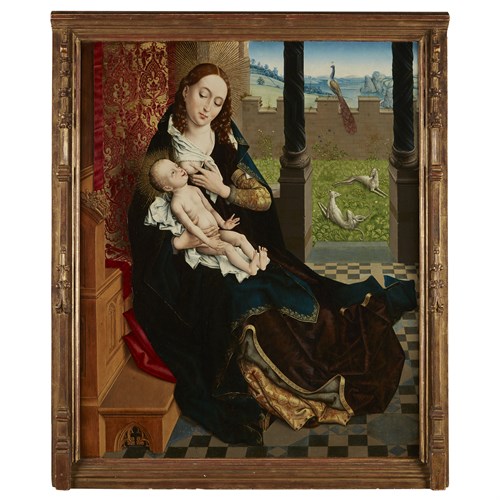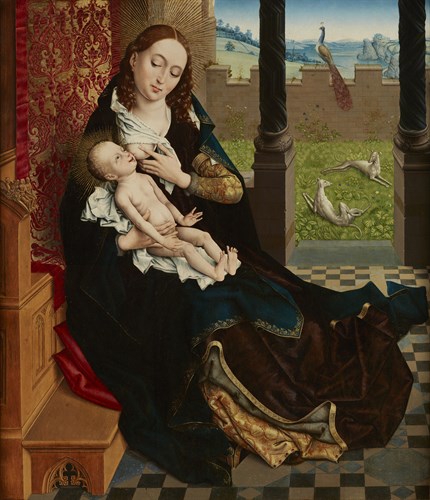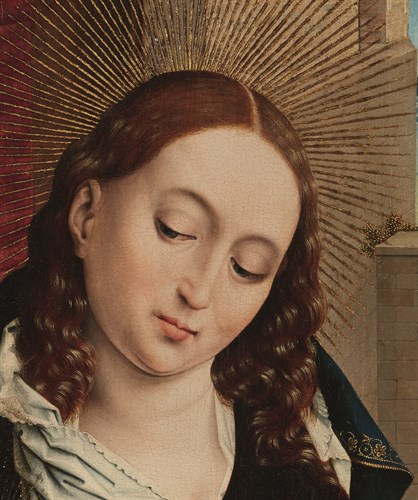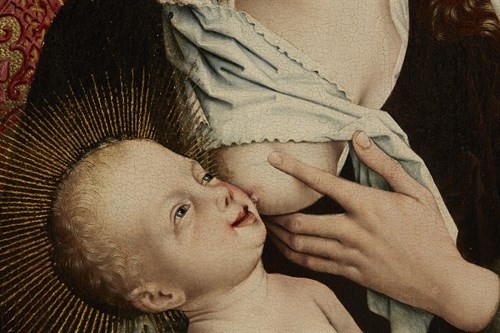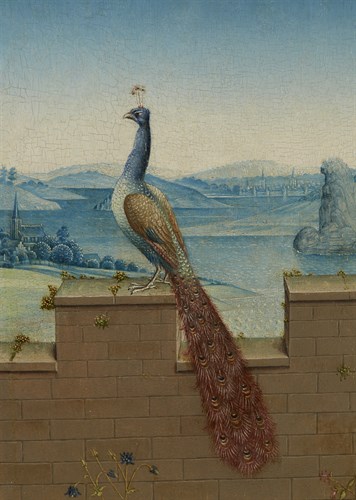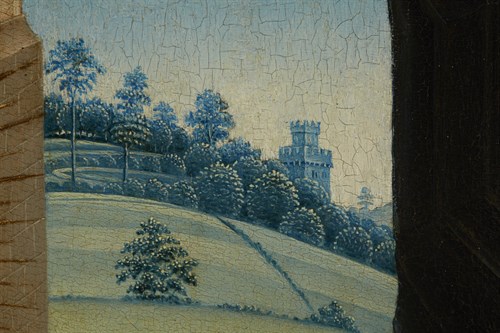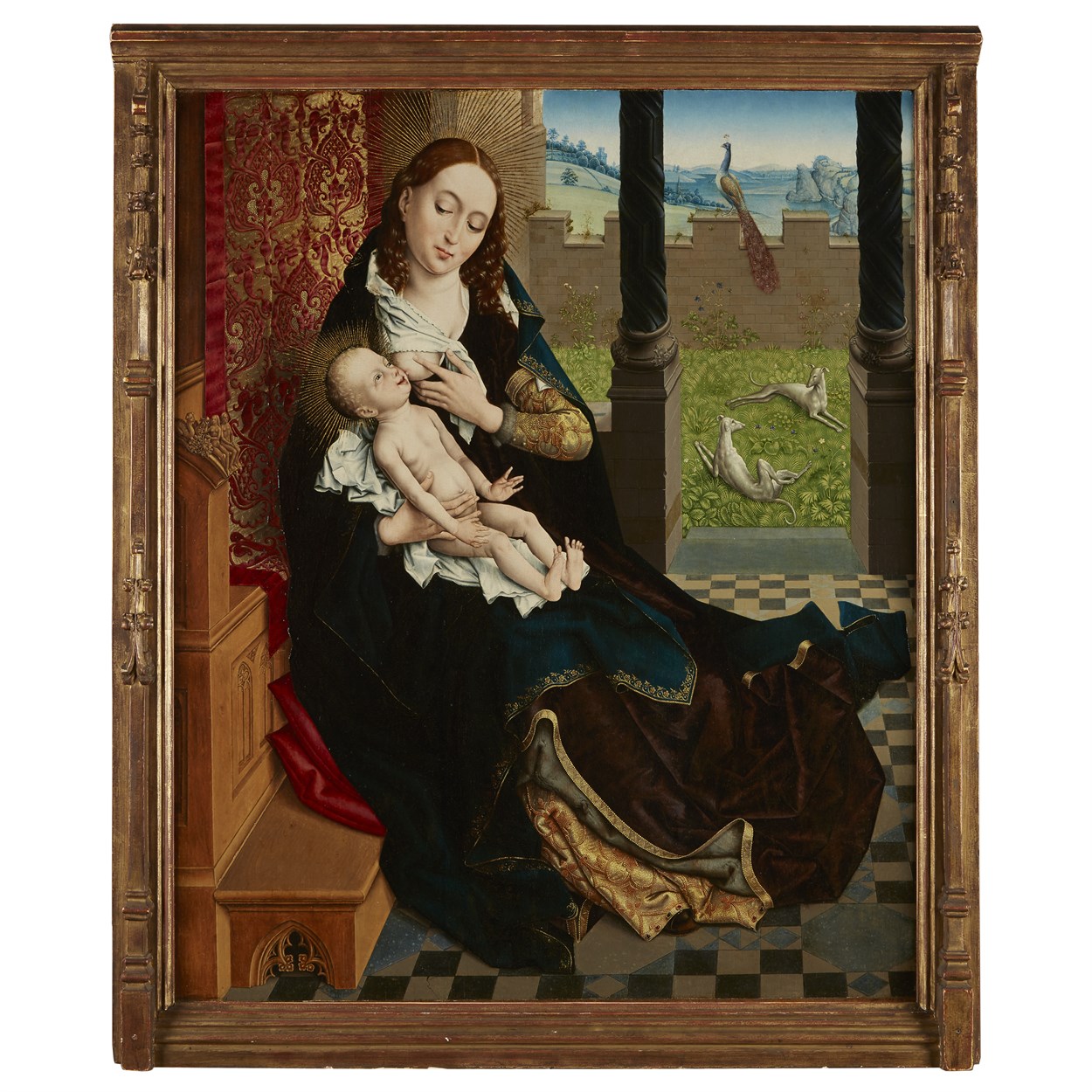February 27, 2019 12:00 EST
European Art & Old Masters: 500 Years
5
Master of the Embroidered Foliage (Netherlandish, active Brussels, late 15th Century)
Nursing Madonna
Oil on cradled panel
33 3/4 x 28 in. (85.7 x 71.1 cm)
Provenance
Private Collection, Spain, 1912.
The Spanish Gallery, London, 1912.
Collection of Sir Francis Beaufort Palmer, United Kingdom, until 1919.
His sale, Christie's, London, sale of April 11, 1919, lot 33.
Buttery, London, 1920.
Collection of Calouste Gulbenkian, London, United Kingdom.
A gift from the above.
Collection of Lord Radcliffe, later Baron Radcliffe, London, United Kingdom.
His sale, Christie's, London, sale of June 26, 1959, lot 45.
Faerber & Maison Ltd., London, United Kingdom.
Christie's, London, sale of May 4, 1979, lot 123.
Collection of Mr. and Mrs. George Farkas, New York, New York.
A gift from the above.
New York University Art Collection, New York, New York.
Sold for $2,470,000
Estimated at $150,000 - $250,000
Oil on cradled panel
Provenance
Private Collection, Spain, 1912.
The Spanish Gallery, London, 1912.
Collection of Sir Francis Beaufort Palmer, United Kingdom, until 1919.
His sale, Christie's, London, sale of April 11, 1919, lot 33.
Buttery, London, 1920.
Collection of Calouste Gulbenkian, London, United Kingdom.
A gift from the above.
Collection of Lord Radcliffe, later Baron Radcliffe, London, United Kingdom.
His sale, Christie's, London, sale of June 26, 1959, lot 45.
Faerber & Maison Ltd., London, United Kingdom.
Christie's, London, sale of May 4, 1979, lot 123.
Collection of Mr. and Mrs. George Farkas, New York, New York.
A gift from the above.
New York University Art Collection, New York, New York.
Exhibited
"Exhibition of Flemish & Belgian Art (1300-1900), Royal Academy of Arts, London, United Kingdom, January 8-March 5, 1927, no. 131 (exhibited as "Rogier van der Weyden.")
"L'Art Flamand dans les Collections Britanniques et la Galerie Nationale de Victoria," Musée Communal-Groeninge, Brussels, Belgium, August-September, 1956, no. 6 (as "School of Rogier van der Weyden").
"Art Treasures Centenary Exhibition," City Art Gallery, Manchester, United Kingdom, October 30-December 31, 1957, no. 21 (as "Master of the Embroidered Leaf").
Literature
Flemish and Belgian Art, 1300-1900, an exhibition catalogue, London, 1927, no. 131, pp. 52-53.
Tancred Borenius, "Memorial Catalogue of the Exhibition of Flemish and British Art," in Sir Martin Conway, London, 1927, no. 131, p. 57.
Max Friendländer, "Noch Etwas über das Verhältnis Rogier van der Weydens zu Memling," in Oud-Holland, 1946, vol. LXI, pp. 15-16.
Max Friendländer,Early Netherlandish Painting, vol. IV, 1967, no. 89, plate 82 (illustrated as "Master of the Embroidered Leaf").
L'Art Flamand dans les Collections Britanniques et la Galerie Nationale de Victoria, an exhibition catalogue, Bruges, 1956, p. 20.
F. Grossman, "Flemish Paintings at Bruges," in The Burlington Magazine, vol. XCIX, January 1957, p. 4, note 12.
Art Treasures Centenary: European Old Masters, an exhibition catalogue, Manchester, 1957, no. 21, pp. 6-7.
Max Friendländer, "Rogier van der Weyden and the Master of Flémalle," in Early Netherlandish Painting, vol. II, Éd. Nicole Veronee-Verhaegen, New York-Washington D.C., 1967, p. 90, add. 137.
Max Friendländer, "Hugo van der Goes," in Early Netherlandish Painting, vol. IV, Éd. Nicole Veronee-Verhaegen, New York-Washington D.C., 1967, no. 89, plate 82, pp. 65, 82 and 101.
Le Maître au Feuillage Brodé: Secrets d'Atelier, Palais des Beaux-Arts de Lille, R.M.N., 2005, fig. 5, p. 18 (illustrated).
Le Maître au Feuillage Brodé: Démarches d'Artistes et Méthodes d'Attribution d'Oeuvres à un Peintre Anonyme des Anciens Pays-Bas du XVe siècle, Symposium organised by Palais des Beaux-Arts de Lille, Librarie des Musées, 2007, discussed p. 173.
Note
Comfortably swaddled in the arms of his mother, the baby smiles. She tenderly looks back at him, seated on the steps of a wooden throne surmounted by a damask baldachin, and gives him her breast, from which a drop of milk has just escaped. Her magnificent draped clothes fall heavily on the floor, whose tiles lead to a small open passage flanked by twisted columns. Outside, everything appears peaceful. Flowers, ferns and grasses are arranged in an amazing and detailed variety. Two white greyhounds face each other in the blooming vegetation, while a peacock scans the horizon, majestically installed on the crenellation of the surrounding wall. In the distance, a river flows gently towards a far away town.
MADONNA LACTANS
The scene depicts the Virgin Mary breastfeeding the Infant Jesus. It belongs to the iconography of the Madonna Lactans, or Nursing Madonna, an intimate 12th century representation of the Madonna and Child, in which Mary is shown nursing Christ.
This painting, attributed to the Master of the Embroidered Foliage since 1926, is an exceptional example of his refined technique. Its composition is based on the comparable figures of Rogier van der Weyden's (1399-1464) Saint Luke Drawing the Madonna, completed between 1435-1440 and now at the Boston Museum of Fine Arts. The stylistic bond between the Master and Rogier van der Wyden is so evident that the present painting was thought to be completed by Rogier van der Weyden himself whilst in the collections of Sir Francis Beaufort Palmer, and Calouste Gulbenkian in the 1920s.
Although our work only copies the left side of van der Weyden's prototype, it is still very much filled with the "spiritual stillness" which characterizes the original painting of Saint Luke Drawing the Virgin, the noblest possible subject of the time (Saint Luke was considered the patron Saint of artists and depictions of him adorned the premises of the painters' guild in various cities in Europe).
A MEDIEVAL MYSTERY
The name "Master of the Embroidered Foliage" was coined in 1926 by German art historian Max Jakob Friedländer (1867-1958), who likened the particular way the artist painted the foliage in his works to the repeated pattern of stitches in embroidery. The director of the Gemäldegalerie in Berlin from 1896 to 1933, Friedländer also worked as a critic and an expert. Throughout his various studies and his countless volumes dedicated to the early Netherlandish painters of the late fifteenth century, he unveiled the existence of several small masters, to whom he gave conventional names. According to Friedländer, the Master of the Embroidered Foliage was active in Brussels in the late fifteenth century and produced (alone or with the help of a dedicated studio) a group of ten paintings, which all depicted the 'Virgin Mary and Christ Child' in similar poses. In each different version of the painting, the Master of Embroidered Foliage used varied backgrounds and made minor alterations to some details of the landscape. These variations and details were likely introduced to satisfy the wishes of individual buyers, which suggests a lucrative market.
Almost all of the paintings attributed to the Master of the Embroidered Foliage were intended to glorify the Virgin and inspire devotion. In this particularly idealized vision of a world without sin, the artist inserted many details to symbolize the ultimate virtue of the Virgin. The throne hints at her future status as the Queen of Heaven, though out of humility, she sits down on the step. It is decorated with sculptural figures of Adam and Eve, individuals responsible for the Original Sin for which Christ and the Virgin will atone. In the background, the loggia gives access to an enclosed garden, or hortus conclusus - a typical representation of a heavenly paradise resembling the earthly world, which here symbolizes the Virgin's chastity. The two white greyhounds in the grass, typically considered the Prince's dogs, refer to Christ's and Mary's purity. As for the peacock, seen in the garden, it is a common Christian symbol of immortality and of Christ's resurrection; legend held that the flesh of a peacock never decayed.
Recently, the painting has been examined under infrared and ultraviolet light. Comparative study of the infrared images and the finished panel indicates that much of the composition was established in detail prior to painting. However, the infrared imaging also revealed that some changes were made during the painting process.
The most significant change is seen in the right background. Originally, the brick wall was positioned further in the distance, and two figures were standing facing the landscape, where the peacock is now perched. Both were underdrawn but not rendered in paint. Such figures, which are generally accepted as Saint Anne and Saint Joachim, the parents of the Virgin, take their inspiration from Rogier's famous aforementioned work. The two figures also appear in The Virgin and Child Enthroned, another painting attributed to the Master of the Embroidered Foliage, and now at the Clark Institute in Williamstown, Massachusetts. The background in the Williamstown painting is indeed, the exact-scale replica, with some modifications, of the background in Rogier's Saint Luke Drawing the Virgin. Although fascinating, this is far from surprising since the Master used a large range of models, and stencils, based on Rogier's paintings before adapting them to his new compositions.
Here, the artist depicts a humanized Virgin Mary, despite the presence of a halo above her head. Through contemporary architecture and landscape, he creates an intimate and familiar space for the viewer to feel assisted in his or her prayers. The small format of the painting, and the fact that it was painted on three narrow sheets of oak panel, also marks a new movement in the Netherlandish art; when private buyers started to collect works of art to enhance their self-devotion, as opposed to life-size altars.
A LANDSCAPIST
Since Friedländer, only two specific criteria have been used by art historians in order to link a work of art to the workshop of the Master of the Embroidered Foliage: the way the artist captured the foliage via small and systematic points of light; and the repetitive use of a motif derived from several compositions of Madonna and Child by Rogier van der Weyden.
When naming the Master of the Embroidered Foliage, Friedländer paid close attention to the way the artist captured the foliage in his paintings. He compared the properly spaced points of light to the repeated pattern of stitches one could notice in embroideries of this time period. According to Édouard de Callataÿ, the Master of the Embroidered Foliage was primarily a landscape specialist who worked for various other masters by painting the background of their paintings, hence participating in the most innovative artists trends of the time. Although this opinion is no longer considered true (too many stylistic differences among the Master's backgrounds and landscapes have been noticed), the special attention given to the landscape in the works of the Embroidered Foliage shows an innovative trend in art history at the time. Traditionally, 15th century landscapists are all studied in a Ganto-Bruges context. As such in her 1991 thesis, C. Fisher decided to compare the floral motifs used by the Master of the Embroidered Foliage, with those that could be found throughout Hans Memling's (1430-1494) oeuvre. Based on the similarities she found, especially in the common rendering of large, stylized ferns, she concluded it was possible that the Master was directly inspired by Memling, who died in Bruges in 1494.
The presence of the two elongated greyhounds in the background of our painting seems to corroborate this assumption, since it clearly recalls the two seated dogs in Memling's famous painting The Allegory of Vanity (now in Musée des Beaux-Arts de Strasbourg), making it a sort of iconographic "signature" used by several Flemish artists over the years to fill their compositional space. Yet, by comparing the Master's work to the art of the tapestry, Friedländer became the first to link his production to a region of Brussels, a city where painters had the sole privilege of producing tapestry cartoons. He confirmed this geographical assumption by proving the repetition of various models of a Virgin and Child after the Rogier van der Weyden, the official painter of the city of Brussels. Today, scholars believe that the Master mainly worked after four models of 'Virgin and Child' by Rogier van der Weyden. They are: The Nursing Madonna from Saint Luke Drawing the Virgin (Boston Museum of Fine Arts), a lost Madonna which inspired the Triptych of Salve Regina of Tournai (Musée des Beaux Arts de Tournai), a seated Madonna and Child, only known through a drawing now at the Boijmans van Beuningen Museum of Rotterdam, and the Madonna Duran at the Prado Museum in Madrid.
STUDIO SECRETS
The Master of the Embroidered Foliage is one of several anonymous painters with a name. Although the name itself is an invention of the early 20th century, the tradition of naming anonymous painters dates back to the late 18th century, when European scholars invented a system of conventional names to identify unknown artists.
Traditionally speaking, each conventional name is composed of the term "Master", as in the one who excels in his art, followed by an adjective made up of a characteristic which can be observed in several works by the artist, such as a year repeatedly inscribed on the artwork, a monogram, or the way the artist depicted a place, a figure or a special motif. This system proved handy, and art historians still name new "Masters" today. In some way, it exemplifies the human need to personalize works of art since the time of the Renaissance - art is considered to be an individual creation, it needs to be attributed to an author in order to survive throughout the years and gain posterity.
Historically speaking, anonymous painters have always been considered minor artists. Their works have largely been depreciated, due to their anonymity, but also because of their quality. Art historians analyzed their paintings as mere copies of great masters such as Jan Van Eyck (1390-1441), Hans Memling or Rogier van der Weyden (although those artists themselves often copied others). Luckily, this hasty judgment has since been revised. It is now commonly accepted that the art of imitating the great masters is far from secondary. On the contrary, it is anchored in a very old tradition, celebrated by Erasmus (1466-1536) himself, who encouraged young artists to look for already-existing images of perfect beauty, in order to recreate them ("The wise architect will choose the most perfect works, rather than common works, and the painter will choose the best paintings when they look for a model"). To really understand the art of the small masters, it is necessary to embrace the idea of a large-scale production directed by craftsmen rather than artists, who are able to reproduce a large number of models via mechanical processes (such as calks and stencils). From the middle of the fifteenth century to the middle of the sixteenth century, the art of copying became an unavoidable phenomenon in the Southern part of the Netherlands. Local artists produced a handful of paintings for the nearby religious brotherhoods, corporations and private collectors, all the more numerous with the emergence of a bourgeois clientele. Altarpieces, domestic altars and simple images of devotion started to invade churches and homes. In order to meet the high demands, artists were forced to simplify their techniques, which ultimately resulted in an aesthetic impoverishment. To compensate for it, artists such as the Master of the Embroidered Foliage developed an art capable of distinguishing themselves: both narrative and decorative.
Today, the Master of the Embroidered Foliage is no longer thought to be a single artist or a unique workshop. According to Florence Gombert, former curator at the Palais des Beaux Arts de Lille and now curator at the Musée du Louvre, the Master's works were not created by a single artist, but probably painted by different artists, from various workshops in the Flanders region, who referred to a common source. To her, it is then preferable to speak of a "group" of the Embroidered Foliage instead of a Master, as it is impossible to capture the personality of only one artist among the dozen works which Friedländer attributed to the "Master," since all show drastic stylistic differences which prove they originated from different workshops from the Flanders region in the late fifteenth century. According to Gombert, the term "group" is the best way to break free from the idea of a single artistic personality or a unique workshop while respecting the coherence of the whole group.
In 2005, the Palais des Beaux-Arts de Lille devoted an entire exhibition to the Group of the Embroidered Foliage. At the time, it was the only show exclusively dedicated to an anonymous Flemish Master of the late fifteenth century, a complete stranger to the general public to say the least, but also an enigmatic figure in the eyes of the medieval art specialists themselves. Since this date, it was made clear that the Group of the Embroidered Foliage was not the small, "systematic, and repetitive" Master which Friedlander first described in 1926. Our painting itself reveals a remarkable composition with a pre-naturalistic sensibility, especially in the careful rendering of the background landscape and its miniaturist details, a symbolistic testament to the urban Europe of the fifteenth century.
